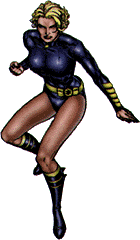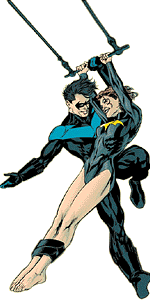
What's good in Comics
Birds of Prey
Drawn by Greg Land and Drew Geraci
Edited by Jordan B. "Gorf" Gorfinkel
 Since I wrote my original review of Birds Of Prey, one more one-shot and 8 issues of their regular series have come out, so I'm posting a revised review. This page includes some text straight from the original page. For those of you with fairly new browsers, that text looks like this. The full text of the original article can be found here.
Since I wrote my original review of Birds Of Prey, one more one-shot and 8 issues of their regular series have come out, so I'm posting a revised review. This page includes some text straight from the original page. For those of you with fairly new browsers, that text looks like this. The full text of the original article can be found here.
Birds of Prey remains a sterling example of one of the comicbook trends that I'm most pleased about: the appearance of strong female characters, not the blood-soaked demonesses of the "bad girl" comics, but positive, strong, self-reliant women and girls, filling the same roles as the men and boys of other books. Several of the books I've reviewed here have had women in starring or featured roles: Jennifer Mays and Chance Falconer, Wonder Woman, Winged Victory, and the First Family's Astra. Birds of Prey, however, stars a team of two women, something that I don't recall having seen before in a superhero book. There have been lots of women partners or team-mates, and single stars, but partnering two women has seldom, if ever been done.
Birds of Prey teams the Black Canary with Oracle, who for the last couple of years has been a mysterious voice and supplier of intelligence and information to many of the heroes of the DC universe. Oracle is the identify assumed by Barbara Gordon, Commissioner Gordon's niece, once known as Batgirl, since she was crippled and confined to a wheel chair by the Joker. Dinah Lance, the Black Canary, is the daughter of the Golden Age Black Canary, Dinah Drake, and for several years was the lover and partner of the Green Arrow. They broke up a couple of years back, shortly before his death.
|
Birds of Prey didn't start out as a regular title, but rather as a series of one-shots and miniseries. All of the stories have been written by Chuck Dixon and edited by Gorfinkel. Each time the art has been done by a different team, some old timers and some new to the business, but all quite good, and more of the school of "Good Girl" art than the "Bad Girl". The art team on the series, Land and Geraci also did BoP: Batgirl, the last special featuring the team.
Birds of Prey gives the Black Canary a new look. Gone are the high-heels, fishnet stockings and long blond wig. Gone, too, is the short-cropped butch hair-cut and punk leathers. Her new outfit does leave her legs bare, but features padded fore-arms for blocking and boots with low heels and heavily t redded soles. In fact, in Manhunt when she teams up with The Huntress and Catwoman and fights Lady Shiva, all four wear sensible shoes. The superheroines and villains in this book are still very sexy, but it's much more the sexiness of an athlete than that of a showgirl or stripper.
The characters of the two women and their complex relationship are also handled more realistically than most comics. Dixon's portrayal of them draws on all the previous incarnations and creates characters that are new but familiar, believable and interesting. Both women have their flaws and weaknesses as well as their strengths. As Birds of Prey opens, Dinah's personal life is a mess. She's broke. She hasn't gotten over the death of Ollie Queen, the Green Arrow, or the fire that destroyed their apartment and Sherwood Florists, the business they shared. Crime fighting is the one part of her life where she is successful. There she can rely on her instincts and abilities. There she is a hero and a winner.
 | |
|
You know guns, Oracle? |
I don't like 'em. But I know 'em. |
Oracle, on the other hand, is haunted by what the Joker did to her. The Batman and her uncle had both tried to warn her about the dangers of crime fighting, urged her not to take the risks and they turned out to be right. The Joker shot and crippled her. Her failure, her recklessness, and her broken body all weigh on her. As a result, she's something of a control freak, and often urges Black Canary to be more cautious. What we quickly realize, and what we watch them slowly learn, is that they complement each other perfectly. Not only do they have strengths that compensate for the other's weakness, but they offer each other the opportunity to work through their problems and the support to overcome them.
Over the course of the 18 stories we've seen so far, both women evolve as characters. In Wolves and Batgirl, Barbara faces danger on her own, in her chair, and overcomes it. By the end of Batgirl, she can actually hold her Batgirl doll and smile. By The Return of the Ravens, Dinah has gotten her confidence back, and in the last few issues we've seen signs that she may be re-evaluating the cockiness and snap judgements that cause them both so much grief. It's really easy to come to care for these two as people.
Of course, the book isn't just about two women working through the problems of the past. Birds of Prey is a superhero comic, after all. Neither woman has any truly superhuman powers. They are non-super heroes of the Batman school, or perhaps more like James Bond or the Shadow's operatives. Their enemies tend to be international organizations, involved in intrigue, white-slavery, terror and the like. Like Bond, the Black Canary drives hot cars and battles world-class villains. Like the Shadow's operatives she works for someone who is nothing but a voice.
Birds of Prey, "Wolves" breaks away from this pattern. In it, both Dinah and Barbara run into trouble in their civilian identities. Being the heroes they are, they prevail in these unexpected problems, and for the first time we see Barbara in physical action, battling a gang of robbers from her wheelchair.

|
The first six issues of the regular series give us two three-issue adventures in the standard costumed superhero vein. Lots of action involving Black Canary, and lots of research, problem solving and network hacking by Oracle. The first story guest-stars Robin, and the second Batman, but bot in small supporting roles that do more to define the characters than directly advance the plot. Several sub-plots weave their way through both stories, including a three-way cyber conflict between Oracle, Roland Desmond and the Feds, and Barbara's net-flirtation with the mysterious "Bumblebeeb". (Keep an eye on Bumblebeeb.com. DC has reserved the domain name and seems intent on giving Beeb a real-word Web site.)
Issues #7 and #8 both advance the characters a lot. In BoP #7, "Best of Enemies!", Black Canary has to safely escort an ex-dictator out of the Balkans to face trial. Someone is trying to kill him before he can leave the country, and Dinah has to protect him, even though she'd just as soon see him dead. Things don't turn out the way she expects, and Dinah's left with a lot of questions about the nature of good and evil, about justice and about her own motives and actions. Great story. Plenty of action and plenty of character development.
Issue #8, "On Wings!" is a definite change of pace. The conflict is between Barbara and herself, and Nightwing, and her past, and her feelings. It's the logical, and beautifully told next chapter in the story that started in BoP: Wolves when Barbara faced the toughs on her own, and which continued through BoP: Batgirl as she fought and beat a costumed villainess, and her triumph over Batman in issue #6. In issue #8, Batgirl is reborn. The spirit that made Barbara Gordon Batgirl in the first place is out and it is stronger than ever. Dixon drives home how real his characters are and how much we care about them, and Land and Geraci bring the images to life. Gosh, I loved this book!
I still recommend this book. In fact I recommend it more than ever. The writing and art have both been high quality. The two lead characters are interesting people, well portrayed, and their relationship is complex and authentic. The book features not one, but two strong women, both people who live according to heroic ideals and who struggle with those ideals. Given the development of the characters, I would also recommend picking up back issues if your local comicbook shop has them.
|| Previous | Comics Page | JimB's Home Page | Next ||